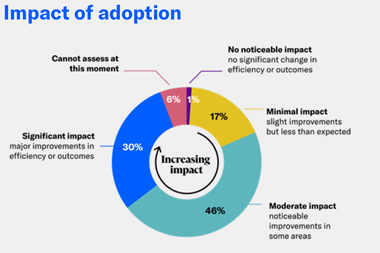Andre Basile examines the risks facing directors and officers from emerging legal challenges
Whichever way you look, the responsibilities of directors and officers of UK and European companies have never been greater. Not only are the standards higher than ever before, but UK and European governments, supported by the judiciary, are actively encouraging the use of collective actions and contingency fees as a way of improving access to justice. This, coupled with the threat of litigation from the American Plaintiffs Bar and the long arm of US law, means that executives are walking a tightrope with the possibility of falling off it on either side of the Atlantic.
The heightened duties of directors and officers create an increased exposure to litigation, chiefly for three reasons. First, the Companies Act 2006 significantly raises the risk bar for directors and officers of UK companies by both broadening directors' responsibilities and simultaneously opening the door to the prospect of new statutory derivative actions. Second, the EU is considering the introduction of damages actions for breach of trust rules, double damages for horizontal cartels (companies cooperating to reduce competition) and the end of the ‘loser pays’ principle. And third, entrepreneurial American Plaintiffs Bar (APB) firms are opening up field offices in London because they see increasing opportunity for litigation here and in the US.
Raising the bar in the UK
Three elements of the Companies Act 2006 raise the risk bar for directors and officers:
• The new duty to promote so-called ‘enlightened shareholder value’
• The expanded ‘Business Review’
• The new statutory derivative action.
Enlightened shareholder value: Since the Companies Act received Royal Assent in November last year, directors must go beyond promoting shareholder value to demonstrate they are promoting ‘enlightened’ shareholder value. This means that they must consider the impact of the company's operations on its employees, suppliers, customers, the community and on the environment, while maintaining the company's reputation and considering the long term consequences of its actions.
As debate rages around how companies will interpret these requirements, one thing is certain. Spelling directors' duties out like this in statutory form will focus attention on how decisions are taken and even more so on how they are documented, in order that an audit trail can be created which explains the corporate decision-making process and justifies the conclusions that are reached.
Since pleasing everyone is an impossibility, given the inherent conflicts between any company's stakeholders, directors and officers will be faced with making difficult decisions. Whatever the debate in the boardroom, insurers will be particularly keen to understand how companies are implementing the explicit duties imposed by the Companies Act and to see that they are creating a defensible position through new and more detailed documentation.
The expanded ‘Business Review’: The Act also introduces a requirement that quoted companies carry out forward-looking reporting as part of their regular shareholder communications. Similar in intention to the OFR (Operating and Financial Review) which the Government proposed and then scrapped in December 2005, the Business Review requires information to be included about future trends likely to affect the company.
The problem for companies is that the more information, particularly of a forward-looking nature, that they are required to provide, the greater the opportunity for public scrutiny, and so the greater the risk of falling short.
The statutory derivative action: Derivative actions have been a reality for some time, but the Act has increased the likelihood that one might be brought. Why? Primarily because the terms are so broad, applying to any ‘negligence, default, breach of duty or breach of trust by a director’ – rather than to a narrow range of specific situations. The Act requires no minimum shareholding: owning one share entitles a shareholder to bring an action. Nor need the claimant have been a shareholder at the time the breach of duty occurred.
This creates uncertainty for companies and opens the door for public interest groups to invest in a company with the sole purpose of forcing a company's hand through a derivative action.
Over zealous and over here
There is considerable concern that the new UK legislation has increased cross-border liabilities, exposing directors to a greater threat of prosecution in foreign courts on the basis of statements made about company performance. Derivative claims are far easier to bring in other jurisdictions, particularly the US, and may not be restricted by the same statutory liability regime as in the UK.
At heart, American class action lawyers are entrepreneurs. The class action is a very powerful weapon and the greater volatility in European markets creates the conditions for shareholder dissent which plaintiffs can tap into as the basis for litigation. The more shareholders a lawyer can represent, the better he will be rewarded.
The SEC (Securities and Exchange Commission) has now entered into over 30 MOUs (memoranda of understanding) with other regulators and this has in turn encouraged the APB to bring more cases against foreign companies and their directors and officers.
The APB recognises not only the US exposure of foreign issuers, but also the value of non-US shareholders being included in US class action litigation.
These shareholders (primarily institutional investors including pension funds) have not previously played an active role in US securities suits. But by including them in US class actions, the APB has succeeded in increasing the damages claimed and ultimately the settlement value of such claims.
What power do US lawyers have?
Plaintiffs can bring a number of different kinds of suit:
• An action against a non-US issuer brought on behalf of US investors
• An action against a foreign issuer on behalf of non-US investors who purchased on a US exchange
• A so-called F-cubed or foreign-cubed action – a suit by a non-US investor, purchasing securities of a foreign issuer on a foreign exchange.
•
These suits, alleging violations of US securities laws, are typically brought against the foreign issuer and its directors and officers, provided the plaintiff can establish that the court has subject matter jurisdiction using the ‘conduct’ or the ‘effects’ test.
Depending on which US federal court considers a case, ‘conduct’ test requirements will vary. They can include anything from significant actions occurring in the US in furtherance of the alleged fraud, to the apparently innocuous – such as carrying out planning or organisational activities while in the US.
Alternatively, plaintiffs can seek to prove that actions taken outside the US – sending an offer document to US investors, or concluding a foreign deal which is disclosed in reports to US investors – had a substantial adverse effect on US investors, thus meeting the ‘effects’ test.
Assuming the court decides there is a case to answer, its powers of summons are very broad, particularly given the amendments to extradition treaties negotiated after September 11 2001.
Trouble ahead in Europe
Adding further to directors' and officers' woes, the EU has published a green paper which considers the introduction of damages actions for breach of trust rules, double damages for horizontal cartels (companies cooperating to reduce competition) and the end of the loser pays principle. In addition there is a raft of relatively new legislation enacted or being considered in the Netherlands, Germany, Spain, Italy and the UK to provide increased rights for consumers bringing collective actions.
Why are collective actions becoming more popular? The first reason is that collective actions provide consumer redress where individual actions might not be large enough to support a legal action. In Sweden for example, when the Kratkommission took over the electricity supply mandate, 7,000 consumers banded together to sue when costs rose. In liberalised markets, the threat of this kind of collective action becomes a form of regulation in its own right, reminding corporates of the need to demonstrate value to the consumer.
Another critical reason why collective action has garnered increasing support is that it opens access to justice for all without the need for legal aid.
In the litigation following the privatisation of the UK's Railtrack in 2001, for example, 50,000 shareholders paid £60 each to create a fighting fund of £3m. While shareholders acting independently would have made little impression, a collective approach paved the way for an action against the Secretary of State for Trade and Industry which cost the UK Government £2.03m in legal fees.
The dangers for companies in these changing times are obvious. There is increasing evidence that we are in an environment where individuals can more easily band together, go off to court and air their grievances. The more shareholders there are, the easier it is to fund an action. Clearly this is a concern for insurers.
Adding fuel to the flames, the old deterrents, such as ‘loser pays’ are also being swept away. Combine this with a parallel increase in reliance on conditional fee agreements (which allow claimants' lawyers to double the fee if they win) and ‘after the event’ insurance, which covers the claimant's legal costs in the event of losing, and claimants can double the stakes at minimal risk.
This difficult situation is being made worse by the emergence of litigation funders which have now made the case in the UK for contingent funding. Twenty five per cent of the first £5m and 23% thereafter has been condoned by the courts so far. Effectively, this means that contingent fees as a foundation stone for class actions are here, a state of affairs which is a growing concern for insurers. The net result of these changes has been increasing awareness among UK and European shareholders of the possibility for collective action and an increasing tendency to use this route to settle grievances.
Implications for business
Clearly these are worrying trends. In the UK, the Civil Justice Council has recommended the introduction of contingency fees. In Europe, governments and judges alike want to increase access to justice by allowing mass actions and contingency fees. This gives the green light to litigation funders seeking to make a business in Europe.
So where does this leave businesses? In the short term there is scope to challenge funding arrangements to try and delay claims and to question whether funders should be regulated. Longer term, companies will have to build into their risk management strategies the increased likelihood that they will face a collective action.
Insurers will watch this space closely, as any litigation trends will impact D&O cover. In the short term, however, we believe that D&O policies generally have the breadth of cover to respond to the exposures that arise.
Andre Basilé is commercial management liability vice president, AIG Europe (UK) Limited, Tel: 020 7954 8312, E-mail: andre.basile@aig.com



















